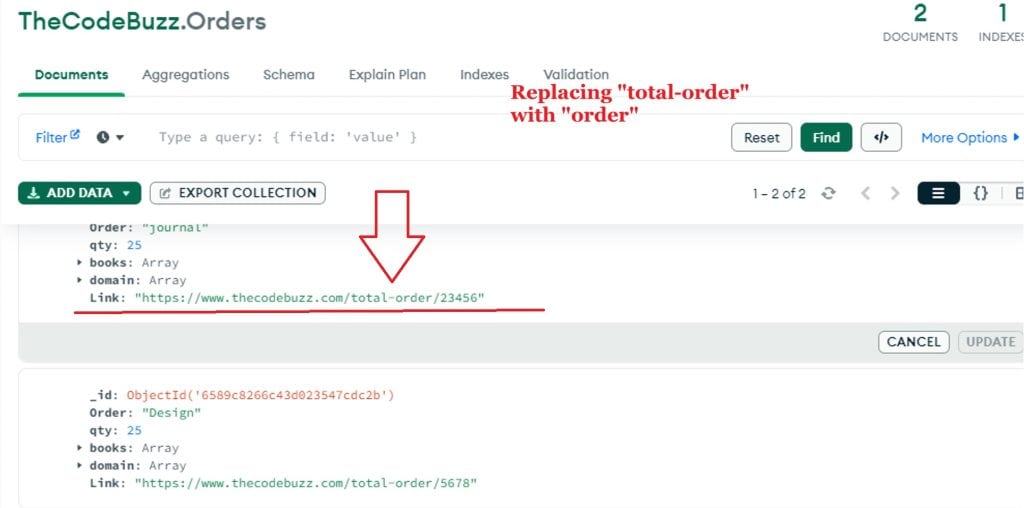C# .NET MongoDB Replace string using $replaceOne

Today this article will learn to write a query using C# .NET MongoDB Replace string using $replaceOne aggregation example.
We will replace a string in the Mongo document with the input string using a simple and easy approach i.e using $replaceOne aggregation operator.
We will cover below aspects,
We will update the records using the Mongo shell query.
We already looked at a simple way of adding or updating a new field to the document in our previous MongoDB sample series.
Getting started
Please add the MongoDB driver NuGet package using the Nuget Package manager.
PM> Install-Package MongoDB.Driver -Version <version>
Note – Please use the latest version available.
Step I – Establish the connection with the MongoDB driver
var _mongoClient = new MongoClient("mongodb://your connection string");
var db = _mongoClient.GetDatabase("TheCodeBuzz");
Step II – Get the collection object for the given Mongo Database
var collection = db.GetCollection("Orders");
Here below is a sample schema or document we shall use,

C#.NET – Replace Substring in MongoDB using $replaceOne Aggregator
We are going to use a newly introduced aggregate operator to replace easily a string with matching criteria with part of the string.
What is $replaceOne
$replaceOne is aggregation operator which helps replace the first instance of a search string in an input string with a replacement string.
This operator usage is case-sensitive.
Query Pattern Replace using $replaceOne
{
$replaceOne: {
input: <expression>,
find: <expression>,
replacement: <expression>}
}
In the above query,
| input | Input string with search criteria. |
| find | Find the document with matching input string criteria. |
| replacement | The string to use to replace the first matched instance from input |
You can replace the existing Mongo field using any other fields from the document using the above approach + using the approach discussed here.
Example using $replaceOne
In the below example, we will replace “total-order” with “order” in the mongo field.
Add below using the required for MognoDB query execution,
using MongoDB.Bson;
using MongoDB.Driver;
using System.Text.RegularExpressions;
Mongo Filter Query
Below query filter all the records with the “Link” field value matching with the “total-order” value.
var filter = new BsonDocument("Link", new BsonDocument("$regex", new Regex("total-order")));
MongoDB C# $replaceOne Query
Below represent a C# representation of the aggregation query,
var query = new BsonDocument("Link", new BsonDocument("$regex", new Regex("total-order"))),new BsonArray
{
new BsonDocument("$set",
new BsonDocument("Link",
new BsonDocument("$replaceOne",
new BsonDocument
{
{ "input", "$Link" },
{ "find", "total-order" },
{ "replacement", "order" }
})))
}
Complete the sample as below,
_mongoClient = new MongoClient(connectionString);
var db = _mongoClient.GetDatabase("TheCodeBuzz");
var collection = db.GetCollection<BsonDocument>("Books");
var filter = new BsonDocument("Link", new BsonDocument("$regex", new Regex("total-order")));
BsonDocument doc = new BsonDocument();
var stageBson= new BsonDocument
{
new BsonDocument("$set",
new BsonDocument("Link",
new BsonDocument("$replaceOne",
new BsonDocument
{
{ "input", "$Link" },
{ "find", "total-order" },
{ "replacement", "order" }
})))
};
doc.AddRange(stageBson);
Create Update Pipeline
Below is how you can create an update pipeline instance as below.

Below is the document post replacing the value of fields.

Do you have any comments or ideas or any better suggestions to share?
Please sound off your comments below.
Happy Coding !!
Please bookmark this page and share it with your friends. Please Subscribe to the blog to receive notifications on freshly published(2024) best practices and guidelines for software design and development.